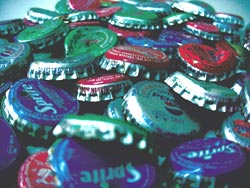 |
|
|
Analysis |
|
| |
| COLANISATION'S DIRTY DOZEN |
|
12 brands of cold drinks put to the test the coolest
event of our times. They put to the test the most aggressive,
glitzy, gutsy, premium, imaginative, high-quality, expensive
and successful attempt to globally grab people’s stomach
share. As it turns out, Pepsi, Mountain Dew, Diet Pepsi,
Mirinda orange, Mirinda lemon, Blue Pepsi, 7-Up, Coca-Cola,
Fanta, Limca, Sprite, and Thums Up are indeed colanisation's
dirty dozen |
 |

CSE |
The Pollution Monitoring Laboratory (PML) of the Centre
for Science and Environment (CSE) places in the public domain
its analysis of the contents of 12 cold drink brands sold in
Delhi. Three bottles of each of the 12 brands were purchased
from markets across the city and analysed to see if they
contained pesticides.
PML tested the cold drink
samples for 16 organochlorine pesticides, 12 organophosphorus
pesticides and 4 synthetic pyrethroides — all of these are
commonly used in India as insecticides, in agricultural fields
as well as at home
The test found:
organochlorine pesticides
LINDANE (g-HCH): This deadly
insecticide damages the body’s central nervous system as well
as immune system and is a confirmed
carcinogen.
| |
|
It was found in 100 per cent of cold drink
samples. Its concentration ranged from 0.0008 milligram per
litre (mg/l) to 0.0042 mg/l in the samples tested. This last
amount is 42 times the 0.0001 mg/l EEC limit — a set of
standards stipulated by the European Economic Commission to
control contamination in water used as ‘food’ — for maximum
admissible concentration for an individual pesticide. It was
found in Mirinda lemon. On an average, lindane concentration
in all brands was 0.0021 mg/l, or 21 times higher than the EEC
norm.
In the popular Coca-Cola brand lindane
concentration was 0.0035 mg/l — a level of concentration which
was 35 times higher than the EEC norms.
DDT AND ITS
METABOLITES (DDD & DDE): Also detected in 81 per cent
of the samples. Absent in Diet Pepsi, their concentration is
as high as 0.0042 mg/l in Mirinda lemon (42 times higher than
EEC norms). On average, total DDT and metabolites found in the
samples stood at 0.0015 mg/l, 15 times higher than EEC limits.
In the popular Pepsi brand it was 16 times higher than EEC
norms. In the equally popular Coca-Cola brand, it was 9 times
higher than the EEC limit.
It found:
organophosphorus pesticides
CHLOROPYRIFOS: Especially dangerous
for mothers-to-be and babies as it is a suspected
neuroteratogen (it causes malformations in foetuses), this
pesticide was found in 100 per cent of the samples. Maximum
concentration was in Mirinda lemon flavour: 0.0072 mg/l , or
72 times more than the EEC single-pesticide norm. The average
amount of chlorpyrifos found in all samples was 0.0042 mg/l ,
42 times higher than the EEC norm.
MALATHION: Detected
in 97 per cent of the samples, its concentration was highest
in a Mirinda lemon sample: 0.0196 mg/l , or 196 times the EEC
limit for a single pesticide. Coca-Cola had malathion 137
times higher than EEC norms. Malathion gets activated in the
human liver to produce malaoxon, deadly for the nervous
system. It is also a confirmed mutagen — it can tinker with
the body’s chromosomal set-up.
In brand
terms
Two multinationals — Atlanta-headquartered The
Coca-Cola Company and New York-based PepsiCo — control the
cold drink market in India. Their market share is a fiercely
contested secret. They also seem to share a penchant for
pesticide residues in their products. Total pesticides in all
PepsiCo brands on average was 0.0180 mg/l, 36 times higher
than the EEC limit for total pesticides (0.0005 mg/l). Total
pesticides in all Coca-Cola brands were 0.0150 mg/l, 30 times
more than the same EEC limit.
In conclusion, the
pesticides found in soft drinks are odiously similar to
bottled water, which the PML had investigated earlier in the
year.
Merchanting madira
By
the 1990s, the carbonated drinks market in the US and Western
Europe was saturated. Companies therefore turned to new ones.
So came the fizz to the Middle East, refurbished East Europe
and Asia. In 1991, PepsiCo entered the newly liberalised
Indian market. 2 years later, Coca-Cola re-appeared (it was
thrown out in the wake of the 1977 FERA regulations). Slowly
beginning to dominate the Indian market — Coca-Cola bought out
Parle Beverages and its brands Thums Up, Limca and Gold Spot;
in 1999 it acquired Cadbury Schweppes’ brands Crush, Canada
Dry and Sport Cola. Pepsi, on its part, took over Mumbai-based
Duke range of soft drinks — they now rule over it. By March
2001, government estimates that 6540 million cold drink
bottles were sold annually in the country. In other words,
with over a billion Indians, each Indian would be drinking
roughly 6 bottles of soft drinks each year (compare: Pakistan,
17 bottles per capita per year; Sri Lanka, 21 bottles; China,
21). In Delhi, the consumption is a whopping 50 bottles per
person per year. Companies are now busy wooing rural markets —
the innovative 200 ml bottle, costing Rs 5-7, has been hailed
as a success. In short, colanisation is here to happen.
|
|
 Aug 6,
2003
Aug 6,
2003 Aug 6,
2003
Aug 6,
2003